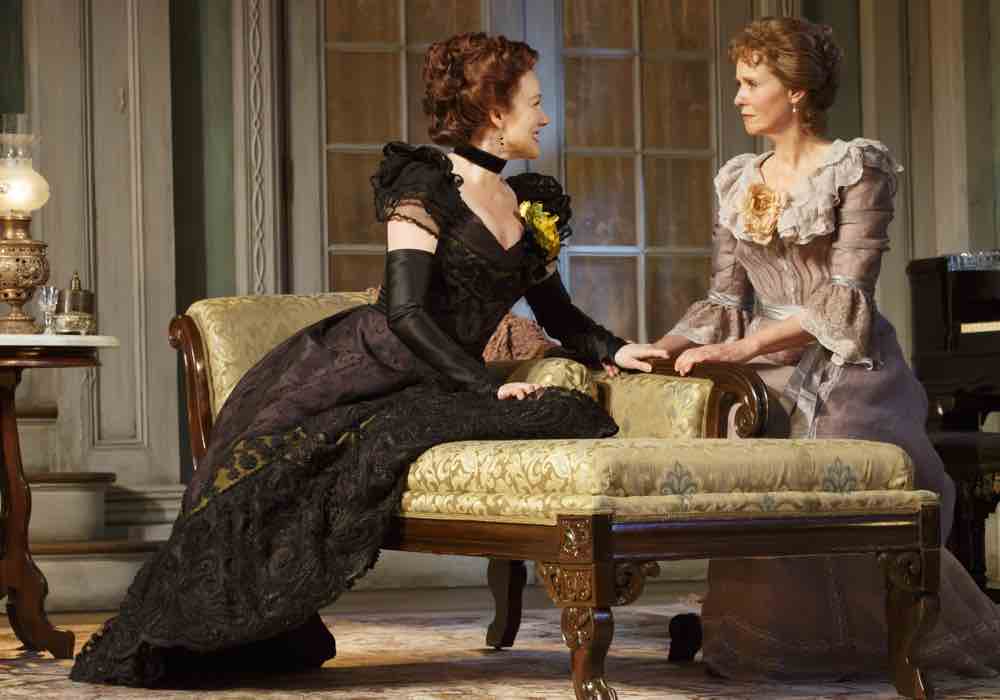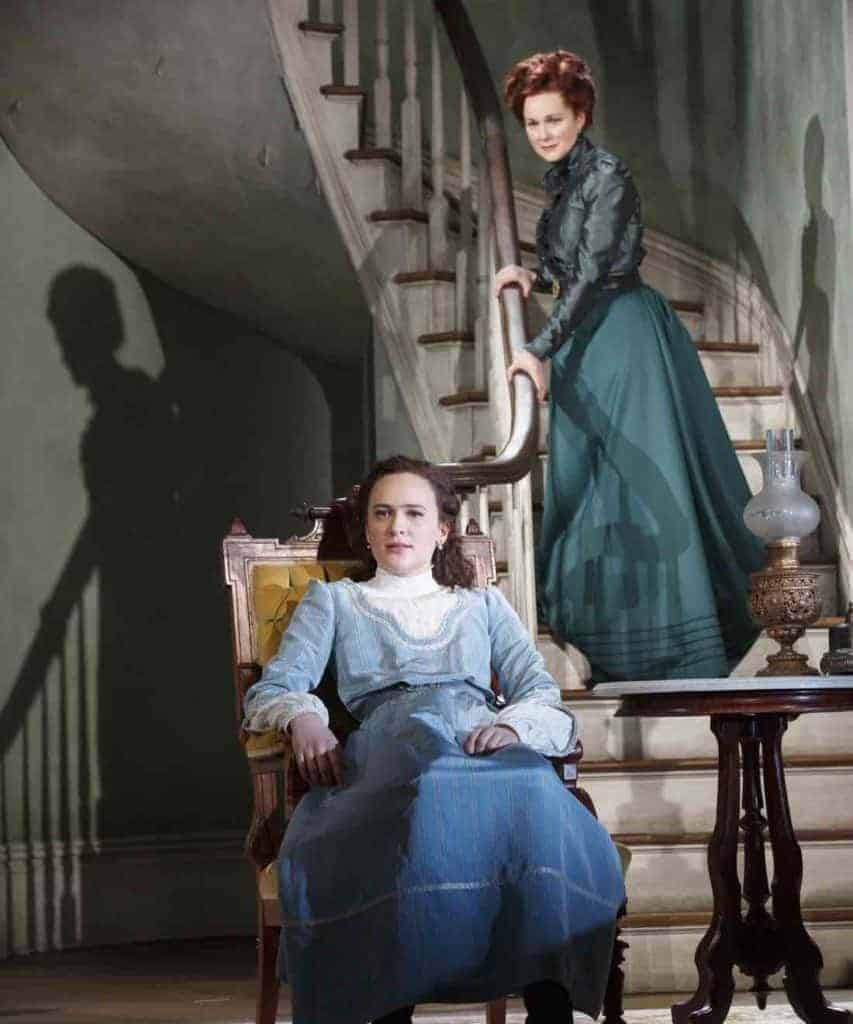Director Daniel Sullivan makes the most out of Lillian Hellman’s uneven Little Foxes, creating a showcase for Laura Linney and Cynthia Nixon.

Lillian Hellman’s The Little Foxes has never been considered a truly great American classic. Hellman’s turn of the century family drama seethes with greed and lust for power, but critics generally consider the characterization uneven — matriarch Regina is, by far, the best written character. Nevertheless, the delicious new revival at the Manhattan Theatre Club (MTC) in New York City makes the most out of its source material. Most of all, this production makes a meal out of the roles for women. MTC plays up the contrast between the play’s two female roles — the main character, Regina, and her abused sister-in-law, Birdie — by having Laura Linney and Cynthia Nixon play both these characters, swapping roles on alternate nights.
At the center of this Alabamian drama, set in 1900, is an infighting family on the verge of making a highly profitable investment. All could be lost for the ambitious but disempowered Regina Hubbard Gibbens when her brothers Ben (Michael McKean) and Oscar (Darren Goldstein) decide to steal $75,000 from Regina’s sickly husband, Horace Gibbens (Richard Thomas). The theft would let Ben and Oscar buy the business for themselves, cutting Regina out of the deal. Once Regina discovers her brothers’ scheme she fights back with a vengeance for her right to the coffer.
Hellman’s characters seek redemption and ultimately win, but it is at a cost. No matter how much she drinks, Birdie cannot hide the pain of being in a physically abusive marriage. Though she can’t escape her marriage, Birdie’s small victory is that she finally allows herself to speak of her injustices, and Hellman gives the broken woman a voice within the play. The more ambitious Regina may win out by gaining a higher percentage from the business deal, but she loses the love and respect of her child for being too manipulative and morally unjust. Now is the time to honour Hellman with this revival production, which proves that Hellman’s examination of women from the 1930s still resonates today.
The beautiful MTC production design transports us into a 1900s sitting room in Alabama without letting this story seem like a relic of the past. Against a rich, white-columned interior with a winding central staircase, Justin Townsend’s lighting design is cunningly realistic, transporting us into the world of the play. The most beautiful naturalistic moment was a scene at dawn where streaks of sunlight shone through the windows with such realism that we forget we’re watching a play. Complementing this naturalistic lighting, Pask dressed the set in lighter colours —seafoam green, green curtains, as well as gold lace curtains along with the white trim. The set transports the audience to another era, which is why the play remains a period play; however, its use of lighter colours and freshness make Hellman’s story feel alive and present. We the audience are invited into Hellman’s world.
Against this pale background, the darker, richer costumes pop, highlighting that the core principal action in the play are the characters coming in and out of the space and they in fact carry the story. Costume designer Jane Greenwood does an impeccable job creating character through the colours and textures of period dress from the early 1900s. While Birdie’s costume felt a little obvious — a softer, weaker character, she only wore pale shades of pink and blue — Regina’s more dramatic costumes were outstanding: Regina is bold, graceful, and daring, so the colour palette of black, burgundy, and dark green reflect this and draws the eye closer to her. Regina’s first black lace dress emphasized her sexual power by boosting her cleavage. Losing this vampy attire later signals a shift in her character: she wears a dark green jewel toned dress that highlighted her need to assert a more domestic form of power within her household and for financial gain. Greenwood added ornamentation on Regina’s shoulders in the form of ruffles, lace, or puffed sleeves, creating a more powerful silhouette and adding to the amount of space she demanded while walking around the room.

Director Daniel Sullivan’s staging shines during the highest points of tension, where he uses movement up and down the staircase to slowly build tension until it erupts in the second and third acts. The second act ends with a volatile offstage fight between Regina and Horace. When it’s over, Regina slowly moves down the staircase, exhausted — but this is just round one. Round two has Regina strutting across the stage, determined, while Horace yells from above on the stairway. The perspective of Horace above and Regina on the main floor yelling at each other is riveting. The blocking suggests that Regina has lost this fight, since she is physically below Horace. But during the climax of the play, Sullivan reverses this physical positioning to chilling effect: Horace has a heart attack and crawls up the stairs while Regina sits close by, just avoiding her husband’s desperate reach.
One of the weaknesses with Hellman’s script is that the supporting characters of Leo, Oscar, Alexandra and Annie could be played really two-dimensionally because they are written as stereotypes. Unfortunately Darren Goldstein’s performance as the prickish and disgusting abusive husband, Oscar, falls prey to this tendency. He shows no humour or variety in his character and thus the performances comes out one-noted.
However, there are two actors within the production that flesh out Hellman’s broadly-drawn characters with humanity and humour. Caroline Stefanie Clay gave the maid character of Annie depth and agency despite the racist rhetoric that overshadows the play. She displayed this in her purposeful walk as well as adding sassy groans and grunts after her lines. Clay’s portrayal undercuts the racist elements of Hellman’s text and makes the character one of the most memorable in the production. Richard Thomas as Horace displayed great moments of discovery in addition to the way he physically transformed into a sickly man. For instance, there is a crucial scene where Regina reveals that Oscar will give up part of his profit in exchange for Horace’s investment. Thomas’ eyes are aglow and he laughs a deep belly laugh because even though the text does not make this explicit, his character realizes this investment will come at a cost. It was delightful to have the audience make a discovery at the same moment the character does, which Thomas so skillfully delivered.
But the real crown jewels of this production are the alternating performances from Laura Linney and Cynthia Nixon. I saw Nixon as Birdie — Oscar’s wife, and the victim of his verbal and physical abuse — who isn’t woven very well into the plot of the play, and in the hands of lesser actors this character could been seen as a piece of sad set dressing. However, by having the two women swap out from the more meatier Regina, it highlights her importance on this production. Birdie is Hellman’s tragic female heroine. She is the passive girl you went to high school with or sit beside in a cubicle while at work. She never thinks well of herself and never speaks up in group functions, but once she has a couple drinks in her, oh boy she begins to show her true colours!
Nixon plays Birdie’s full fragility and vulnerability, but also highlights her sarcasm, which is where this character finds her strength. Nixon’s voice is frayed, high pitched, and nervous while her actions are jumpy. She holds back tears when she talks about why she dislikes her husband and sways her body slightly during these emotionally charged moments. After Birdie has a couple glasses of wine her bitter sarcasm starts to creep in. When Annie cautions Birdie that she is going to get a headache from drinking too much, Nixon sharply responds, “I’ve never had a headache in my life.” The audience roars with laughter at the irony: to prevent Birdie from drinking too much, Oscar would say in front of guests, “Oh she has a headache.”
Laura Linney makes Regina Hubbard-Gibbens relevant today as a woman who wants to have it all: money, status and power. Every moment Linney is on stage is thrilling because the audience never can anticipate Linney’s choices. Her Regina is morally grey and full of fire, a master manipulator and actor who shifts seamlessly between roles even within the same scene — and in doing so, exposes herself as a wolf in sheep’s clothing. Linney digs into the text and plays a different intention on every line: she may be charming on one line, play the victim on the next line and then bark back commands on the final line of the same speech.
All of these complexities showcase her modern touch with the character, portraying Regina as a complex woman whose chief characteristic is that she is driven. She could be the high powered CEO on Wall Street or the mother who is looking for the best school for her child. Linney’s movements create character just as much as her line readings: she can sway her hips when she charmingly asks for something or she can walk more determinedly leading with her head when she is truly fighting for what she wants. All is possible with Linney’s Regina, which is why MTC’s production is worthwhile — it is a valiant, almost-successful attempt to revive an uneven play..
Theatre Review: Simon McBurney’s The Encounter has to be experienced live
Doubles and disguises reign in Desdemona Chiang’s excellent As You Like It at CalShakes

